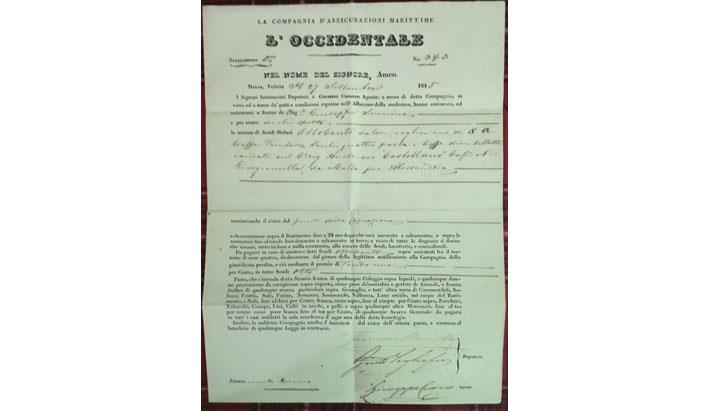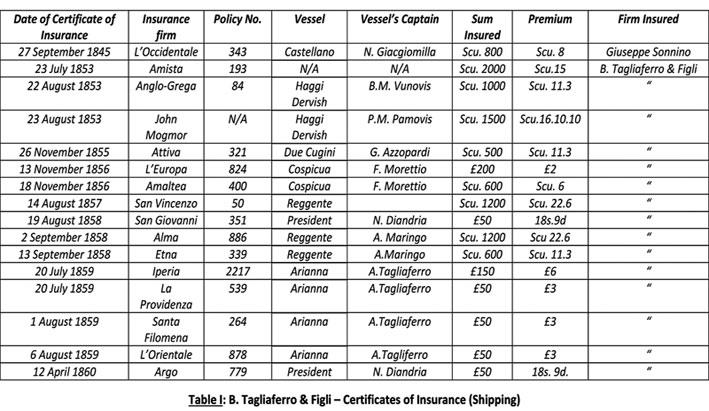Biagio Tagliaferro was born in Genoa in 1777 into a seafaring family. The recent discovery of a cache of 16 very well-preserved certificates of insurance (maritime) from the mid-1800s, (1845-1860), pertaining to B. Tagliaferro e Figli give a detailed account of information on how insurance business was carried out.

Table I, presented in this feature, gives interesting data of the date of certificates of insurance, insurance firms, policy number, vessel, vessel's captain, sum insured, premium and firm insured. Included in this feature is also a list of the gentlemen who were stakeholders in the Shipping Insurance Company, L'Europa. On 19 November 1856, this company had a capital of scu. 100,000 and was registered in the Acts of Notary W. J. Stevens.
The above is a rare find meriting further research on Biagio Tagliaferro and, among other matters, how the grain trade was conducted in the mid-1800s in Malta.

Historical currency and units of measure of Malta
The salma (plural salme), sometimes written in English as salm, was a Maltese unit of volume, and was 98.5% of an imperial quarter, that is, 286.59 litres. From 1875 it was declared exactly equal to an imperial quarter, that is, 290.95 litres.
The silver scudo (plural scudi) was the currency of Malta until 1798, and remained in circulation until 1825, when it was replaced by the British pound at the rate of £1 = 12 scudi. It was subdivided into 12 tari (singular taro), each of 20 grani with six piccioli to the grano.
The exchange rates used here are those given by Mallia-Milanes (1988, p. 135), that is, £0.1 to the scudo from 1781 until 1798 and £0.083 to the scudo from 1801 until its replacement by the pound in 1825. The UK pound (£) was equal to 20 shillings (s.), which were equal to 12 pennies.

Who was Biagio Tagliaferro?
Dr A. Bonnici KM, MD, MRPSL in his research paper titled, Entries addressed to Sigri. B. Tagliaferro e figli, in Malta gives a very wide exposition of who was Biagio Tagliaferro. Tagliaferro was born in 1774 in Genoa. He had come to Malta around 1804 together with his brother Francesco, who had become the longest serving Russian Imperial Consul in Malta, from 1836 till his death in 1878.
In 1812, established a private bank in Malta called B. Tagliaferro e Figli. This bank, which he fully owned, had its offices at l06 St John Street, Valletta, on the left hand side of St John's Cathedral. In its early days, it dealt mainly in ship handling and grain financing. By 1816 Tagliaferro was master of the full rigged ship spelt in Maltese Strangier which means stranger, owned by John Stuart of Valletta. This ship was acquired by the Tagliaferro family in 1822. It was in this period that they established themselves as the leading grain merchants in the Russian Black Sea grain trade.